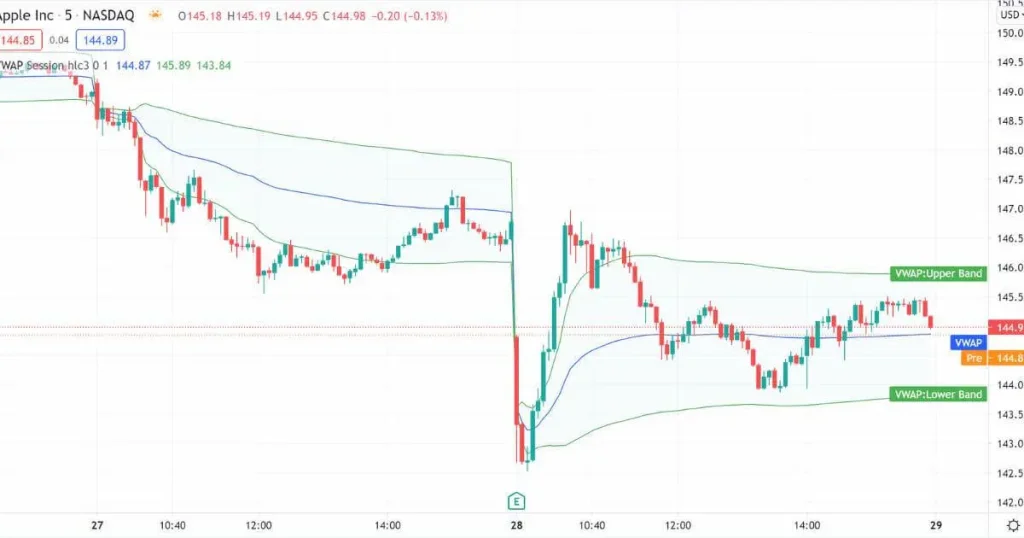VWAP stands for Volume-Weighted Average Price. It’s a trading tool that helps traders understand the average price of a stock based on its trading volume and price. Think of it as a way to determine what most people paid for a stock during a trading day. VWAP is different from the simple average price because it gives more importance to prices with higher trading volumes.
VWAP is essential because it helps traders see if they are getting a good deal on their trades. You might get a bargain if you buy a stock below the VWAP. You could make a smart profit if you sell stock above the VWAP. Big trading companies use VWAP to ensure they buy or sell stocks at reasonable prices.
This article will explain everything you need to know about VWAP. We’ll start with the basics and then dive into how VWAP works, how to use it, and why it’s important. By the end, you’ll understand how to use VWAP to make better trading decisions.
Table of Contents
Demystifying VWAP: A Conceptual Overview
VWAP stands for Volume Weighted Average Price. It’s a tool that shows the average price of a stock but with a twist. It considers both the cost of the stock and how many shares were traded at those prices.
The Basics of VWAP Calculation
VWAP is calculated by adding up the money spent on the stock and dividing it by the total number of traded shares. Here’s a simple way to think about it:
- Multiply each trade’s price by the number of shares traded at that price.
- Add up all these values to get the total money spent on the stock.
- Divide this total by the total number of shares traded.
Formula for VWAP
The formula for VWAP looks like this:
VWAP=∑(Price×Volume) / ∑Volume
This means you take the sum of all the prices times the volumes and divide it by the sum of all the volumes.
Explanation of Components: Volume and Price
- Volume: This is the number of shares traded. If more shares are traded at a certain price, that price is more important in the VWAP calculation.
- Price: This is the cost of each share. VWAP considers all the different prices at which shares are traded throughout the day.
Comparison to Other Price Indicators
VWAP is different from other price indicators like moving averages. Moving averages just take the average price over a certain period, without considering the volume. VWAP, on the other hand, tells you the average price considering how much stock was traded at each price. This makes VWAP a more accurate reflection of what most traders are paying for a stock.
For example, if a stock has been trading at $10, $12, and $15 with many shares traded at $12, the VWAP will be closer to $12 because it considers the volume of shares traded at each price. A simple moving average would just average the three prices without weighting them.
Using VWAP helps traders make smarter decisions by showing them the true average price of a stock considering both price and volume. It’s a useful tool whether you’re buying or selling stocks, and it can help you see if you’re getting a good deal.
Why Does VWAP Matter?
Understanding the significance of VWAP requires delving into its practical applications and the advantages it offers to traders.
Identifying Market Trends
One of the primary benefits of VWAP is its ability to reveal prevailing market trends. Traders use it to distinguish between periods of price movement driven by significant trading volumes and those influenced by lighter activity. This insight helps traders align their strategies with the prevailing market sentiment.
Consider this analogy
Imagine you’re at a bustling marketplace. The items being sold in high volume are likely to be more popular or in demand. Similarly, in trading, stocks or assets with higher trading volumes are often indicative of market interest.
Intraday Trading Strategies
For day traders, VWAP serves as a crucial tool for intraday trading. By comparing the current price of an asset to its VWAP, traders can assess whether the asset is trading above or below its average price. This information aids in making decisions about entering or exiting positions.
Picture this scenario
You’re driving, and the traffic signal turns red. You instinctively compare your speed to the average speed you’ve maintained so far. If you’re moving slower than your average, you might adjust your speed to catch up. Similarly, traders adjust their strategies based on how the current price compares to the VWAP.
Execution of Large Orders
For institutional investors executing large orders, slippage can be a concern. VWAP helps mitigate this risk by allowing traders to execute orders in smaller chunks throughout the day at prices aligned with the average market conditions.
Think of it like a buffet
If you’re hosting a large gathering, serving the food in smaller, manageable portions ensures everyone gets a fair share without creating chaos. Similarly, executing large trades in smaller portions throughout the day avoids disrupting the market equilibrium.
Step-by-Step Guide to Using VWAP
Now that we’ve established the importance of VWAP, let’s walk through a step-by-step guide on how traders can effectively incorporate it into their trading strategies.
Step 1: Choose the Right Time Frame
Selecting an appropriate time frame is crucial when using VWAP. Different time frames cater to different trading styles. Day traders might opt for shorter time frames, such as 5 or 15 minutes, while swing traders could choose daily or weekly intervals.
Step 2: Understand the VWAP Line
VWAP is often represented as a line on a price chart. Understanding this line is key to interpreting market dynamics. When the current price is above the VWAP line, it suggests a potential uptrend, while prices below the VWAP may indicate a downtrend.
Step 3: Combine VWAP with Other Indicators
While VWAP is powerful on its own, combining it with other technical indicators can enhance its effectiveness. Common pairings include moving averages, Bollinger Bands, or Relative Strength Index (RSI).
Step 4: Adapt Your Strategy Based on Market Conditions
Market conditions are dynamic, and a successful trader adapts accordingly. If the current price significantly deviates from the VWAP, it could signal an opportunity or a risk. Traders should be ready to adjust their strategies based on these deviations.
Addressing Common Misconceptions About VWAP
Despite its widespread use, some misconceptions surround VWAP. Let’s debunk a couple of them to ensure a clearer understanding.
Myth 1: VWAP Works Only for Intraday Trading
While VWAP is popular among day traders, it’s a versatile tool suitable for various trading styles. Swing traders and long-term investors can also benefit from incorporating VWAP into their analyses.
Myth 2: VWAP Guarantees Profit
No trading tool can guarantee profits, and VWAP is no exception. It’s a valuable guide, not a crystal ball. Traders must use it in conjunction with other indicators and their judgment.
In the complex world of trading, having a reliable tool like VWAP can make all the difference. By understanding its calculation, applications, and potential pitfalls, traders can navigate the markets with more confidence and precision.
VWAP isn’t just an indicator; it’s a compass guiding traders through the tumultuous seas of financial markets. As you embark on your trading journey, consider VWAP as your trustworthy companion, helping you navigate the waves and steer towards success.
Frequently Asked Questions (FAQs) VWAP in trading
1. What Is the Significance of VWAP in Trading?
VWAP, or Volume Weighted Average Price, is significant in trading as it provides a dynamic average price of a financial instrument weighted by its trading volume. Traders use VWAP to gauge market trends, execute orders, and make informed decisions based on prevailing market sentiment.
2. Can VWAP Be Used for Long-Term Investment Strategies?
While VWAP is commonly associated with intraday trading, it can be adapted for long-term investment strategies. Long-term investors can use VWAP to identify entry points, assess the overall market sentiment, and make decisions aligned with the average price over extended periods.
3. How Often Should Traders Adjust Their Strategies Based on VWAP?
Traders should be adaptive and adjust their strategies based on market conditions. Monitoring VWAP regularly, especially during volatile periods, is advisable. However, constant adjustments may not be necessary for long-term investors, whereas day traders may need to reassess more frequently.
4. Is VWAP a Guarantee of Profit in Trading?
No, VWAP, like any other trading tool, does not guarantee profits. It is a valuable indicator that aids in decision-making, but success in trading depends on a combination of factors, including market understanding, risk management, and overall trading strategy.
5. How Can VWAP Help Prevent Slippage in Large Orders?
VWAP helps prevent slippage in large orders by allowing traders to execute orders in smaller increments throughout the day. This approach ensures that the order is filled at prices closely aligned with the average market conditions, reducing the impact of the order on the overall market.
- Strategies for Firing an Employee Who Is Not a Good Fit - March 25, 2024
- How Managers Today Differ from Managers in the Past - February 7, 2024
- The World of NFT Trading Cards - December 30, 2023



